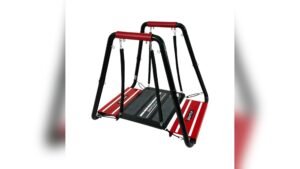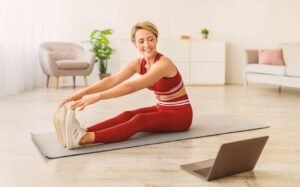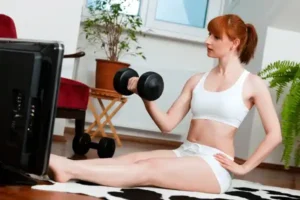Have you ever tried to do a downward dog on a wooden floor? Or did you try to do crunches on a thin rug? Then you know how vital a good workout mat is. Scroll through this definitive exercise mat thickness guide to get an idea.
It’s not just about having your own room; it’s also about protecting your joints as you do one more rep or stretch a little further. What thickness workout mat is best for your routine, though? There are so many to choose from.
Table of Contents
ToggleUnderstanding Exercise Mat Materials: Comfort Meets Durability
The base of any good workout mat is its material. Foam, rubber, PVC—each has its place. Foam offers cushion and comfort at a friendly price, while rubber boasts unmatched durability and grip. PVC mats strike a balance, offering a little of both worlds. But here’s the catch: not all thicknesses are made equal nor suitable for every form of exercise. How thick should an exercise mat be to marry comfort with stability? Let’s dive in.
Types of Exercise Mats by Thickness
The thickness of your mat should depend on the type of exercise you plan to do most often. For more intense and fast-paced movements, a thinner mat might be better for high-intensity workouts. On the other hand, a meditation or low-impact stretching session might need a thicker mat for sitting or lying down for long amounts of time.
Thin Mats (1mm-3mm): The Traveler’s Delight
Ideal Uses for Thin Mats
A thin exercise padded mat is your go-to for travels. It’s lightweight, easy to roll up, and can be used for more than exercise. It provides a barrier from the floor, but it won’t offer much cushioning.
Pros and Cons of Thin Mats
While the pros are portability and ease of storage, the cons lie in comfort. A thin mat may not be the best friend for bony knees or sensitive wrists.
Standard Mats (4mm-5mm): The Jack of All Trades
In the fitness world, standard exercise mats, usually between 4mm and 5mm thick, are the workhorses. These shoes are known as “Jack of All Trades” because they suit many workouts. After all, they are both soft and firm.
Who should use a mat of a standard thickness?
A standard exercise mat, with its moderate thickness, is perfect for those who enjoy diverse workouts, including Pilates, yoga, and solo exercises. Its versatility offers the right balance of comfort and support, making it an excellent choice for various fitness routines. So, if you’re into different workouts, consider a standard-thickness exercise mat as your go-to fitness companion. It feels good and gives you the proper support, whether thick or thin.
Maintenance and Longevity
A quick wipe down after each session and storing it away from sunlight will help your mat last longer, maintaining its integrity and ensuring it stays a cushioned workout mat for years to come.
Thick Mats (6mm and Above): The Comfort King
Thick mats that are at least 6 mm thick are the most comfortable. It feels like you’re working out on a cushion when you use these mats because they are so soft and cozy. A thick mat can be beneficial if you like to do exercises while sitting, lying down, or moving slowly. It will make you feel comfortable and at ease.
Activities Best Suited for Thick Mats
Comfort and Support:
A thicker mat will usually give you more cushioning, which is helpful for yoga or Pilates where you may be sitting down or on your knees a lot. This extra padding can help your joints feel better and make the surface more comfortable for longer workouts.
Strength for Balance:
For workouts that focus on balance, thinner mats can provide more strength. If you do a lot of balance or standing poses as part of your workout, a smaller mat might help you stay in contact with the floor better and improve your form.
Moving and storing:
Mats that are thicker may be heavier and harder to move around. A thinner, lighter mat might be better if you move a lot or have to carry your mat long distances.
Floor Surface:
Think about the surface you’ll be working out on. On a hard floor, a thicker mat may be needed to protect you, but on a carpeted or softer surface, a smaller mat may be enough. In the case of people with sensitive joints or long-term pain, a thicker mat can provide the necessary cushioning to make workouts more comfortable and long-lasting.
Thickness vs. Density for Heavy-Duty Use
Thickness: A thicker exercise mat usually has more padding, which can be helpful for exercises where you need to lie down, sit, or do moves that require you to touch the mat. Using it during floor movements can help protect your joints and make them feel better.
But for heavy-duty use, there might be better choices than too much width. When big weights are put on thick mats, they can give way, making weightlifting less stable and safer.
Density: The density of a mat tells you how tightly the items inside it are packed together. Most of the time, thickness is more important than width when something is used heavily. The surface of a dense mat is firm and stable, so big weights can be put on it without making it too soft. Lifting weights or doing other high-intensity workouts is essential for keeping good form and lowering your risk of injury.
Tailoring Thickness to Personal Preference
For low-impact, slow movements, go as thick as you like for comfort. Here, the cushioned workout mat is for relaxation as much as for exercise.
Considerations Beyond Thickness
A non-slip surface is crucial to prevent injuries. The size should match your frame and the range of your movements. And let’s not forget the environment—a non-toxic, eco-friendly mat can ease your mind as much as your body. When it comes to price, balance cost with quality to find a mat that offers value over its lifespan.
How to Choose the Right Thickness for You
Assessing Your Personal Needs
Consider what you do most of. High-impact aerobics? Gentle stretches? Or a bit of everything? Your activities will dictate the thickness needed.
Tips for Testing Mats Before Purchasing
Try before you buy. Stand on the mat, check for balance, lie down, and note comfort. It’s the best way to gauge the right fit.
Care and Maintenance of Your Exercise Mat
To ensure your mat stays hygienic and intact, clean it regularly. Keep an eye out for wear and tear, and know when to say goodbye to your trusty mat—typically when it starts to lose shape or no longer provides adequate support.
Conclusion
It’s about more than just comfort when looking for the right thickness of exercise mat. It’s also about improving your performance and keeping your body safe. Your muscles, joints, and balance will all thank you if you take the time to find the right fit. Ultimately, what you’re standing on is what makes a good workout plan work. You can reach your exercise goals with confidence and ease if you use the correct mat.
Frequently Asked Questions
1. What is the ideal exercise mat thickness for yoga?
For most yogis, a mat around 4mm thick is ideal as it balances cushioning and stability.
2. Can a mat be too thick for exercise?
A too-thick mat can compromise balance, especially during standing and balancing exercises.
3. How do I know when to replace my exercise mat?
Replace your mat when it starts to lose shape, become compressed, or show signs of wear that can affect its functionality.
4. Is a thicker mat better for my knees?
If you have sensitive knees or joints, a thicker mat may provide the additional cushioning needed for comfort during exercise.
5. Are there eco-friendly options for exercise mats?
Many mats are now made from sustainable materials like natural rubber, jute, and organic cotton. Look for certifications or company statements on eco-friendliness for assurance.
NB: For yoga and Pilates, the best thickness for an exercise mat offers stability for standing poses and cushion for seated or lying poses.







